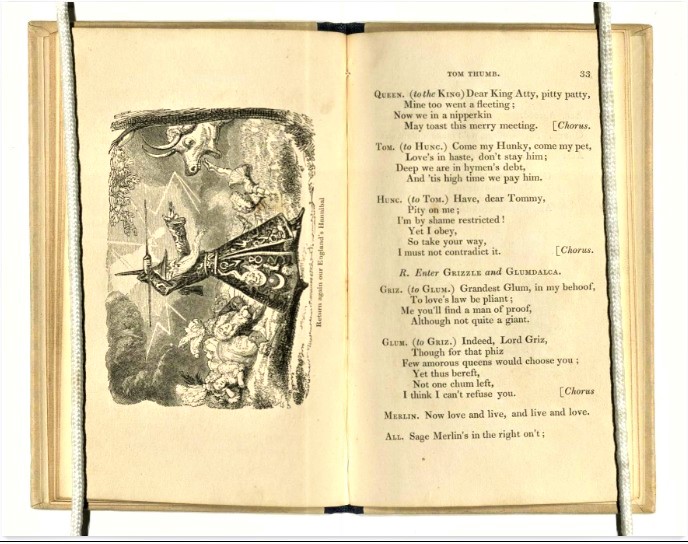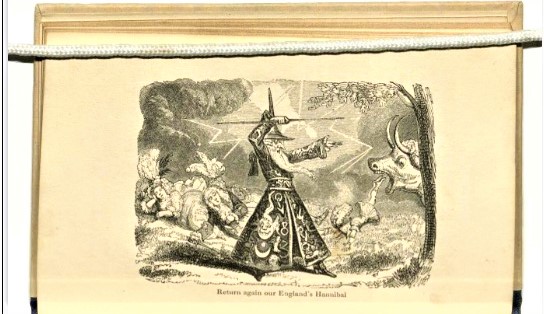by Harley Khaang

What were some of the most popular forms of entertainment for those living in the nineteenth century? Books and theatre had been available to the public long before, as were caricature illustrations which had become popular starting in the sixteenth century. It was during the time of George Cruikshank’s most active period that such forms of entertainment as tableaux vivants, popular serials, and charades became hugely popular.
Tableaux vivants, or living pictures, was a form of entertainment where individuals recreated well-known or popular works of art by posing silently as if they were the art piece. Serials, especially with illustrations, were enormously popular with the masses because of the visual theatricality that enhanced the narrative. Charades consisted of individuals acting out a word or a phrase while those in attendance tried to guess correctly what was being acted out.
It was also during the nineteenth century that theatre gained popularity with the middle class, who until this point had considered theatrical productions unsophisticated and “disreputable” (Golden 51). The common theme amongst these forms of entertainment is theatricality. The combination of text and illustration (visual storytelling) provided the audience with an immersive experience, more entertaining than narratives without illustration or visuals without a narrative. This may explain the immense popularity of George Cruikshank’s illustrations during this time.
The popularity of George Cruikshank’s illustrations may lie in their staging, with each piece resembling an illustrated tableau vivant. Each piece—complete with actors, costumes, lighting, set pieces, and staging—looks similar to a frozen scene from a theatrical production, much like a painted tableaux vivant. George Cruikshank’s use of all the components of a stage play gives the reader a frozen scene from a live stage production in a serial or book. In Tom Thumb; A Berletta, each of his illustrations is a tableau vividly recreating a scene from the story and engaging the imagination of the reader.
Tom Thumb; A Berletta is based on a 1730 play by Henry Fielding. Part farce, part satire, the play is about Tom Thumb, a man small in stature in both body and social status, who is given the hand of a princess in marriage, and the chaos that ensues by those who are determined to prevent the union.

In this illustration Merlin the Magician comes to the defense of Tom Thumb, defeating those who are working to prevent this marriage from taking place. Merlin, center stage, clothed in his majestic robe, his magic wand above his head, demands the return of Tom Thumb to his rightful place next to his princess. With Tom Thumb’s enemies on the ground cowering in fear, George Cruikshank utilizes lighting (and lightning), to convey Merlin’s supernatural powers at work. In looking at this piece one can almost feel the electricity from the magical force pouring forth from Merlin through his sorcery. A story of good versus evil, Tom Thumb, with its underdog protagonist, is a story of triumph with the help of supernatural powers.
Catherine J. Golden writes about the theatricality of George Cruikshank’s illustrations in her book The Evolution of the Victorian Illustrated Book. Golden, a professor of English and the Tisch Chair in Arts and Letters at Skidmore College, compares his illustrations to stage plays and writes that many of his serials were restaged as live dramatic productions. That is because his illustrations were designed much like a play, allowing them to be adapted to the stage with ease. Part of George Cruikshank’s theatrical perspective may stem from his own abilities as a performer.
George Cruikshank had a talent for performing according to Ruari McLean, who writes in George Cruikshank: His Life and Work as a Book Illustrator: “There was in him a strong vein of actor, which came out in both a perpetual readiness, all his life long, to sing and act comic songs, and an uncanny ability to get inside the skins of the book-characters he drew” (McLean 11). Perhaps George Cruikshank’s ability to turn his illustrations into a scene from a theatrical production is born of this longing to be on stage – his lifelong desire to perform channeled into the etchings, each piece bringing him closer to his unrequited dream of being center stage.
For more on the life and works of George Cruikshank please visit George Cruikshank Illustrations and Papers at the UMBC Digital Collections.

 Albin O. Kuhn Library & Gallery
Albin O. Kuhn Library & Gallery